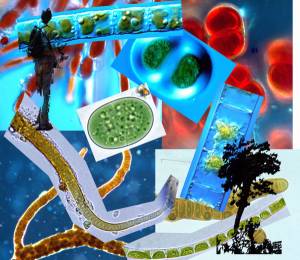Phil Novis
Contact:
Manaaki Whenua - Landcare Research,
P.O. Box 69,
Gerald St,
Lincoln 8152
Webpage: http://www.landcareresearch.co.nz/research/...
Supervisor:
Dr. Ilse Breitwieser

Have you considered that you might be related to a tree? Hundreds of millions of years ago, plants almost certainly shared some common single-celled ancestors with animals, fungi, and other modern forms of life. Of course, not all the descendants of these unicells became multicellular. There is still an enormous abundance of comparatively simple single-celled organisms that have persisted into the present day, and a whole continuum of complexity between these single cells and ourselves.
It is in this continuum that most of the algae are found.
What are algae? Usually they are microscopic in size, and fix carbon by photosynthesis - but not always! The simplest algae are actually a group of photosynthetic bacteria. The most sophisticated algae bear a striking resemblance to the simplest plants. However, this does not always imply relatedness. For example, the algae known as seaweeds have independently reached a level of sophistication comparable to that of a land plant.
My postdoctoral research includes algae from both ends of the spectrum of complexity, and is divided into three parts until July 2004.
1. Latitudinal Gradients Project (LGP): DNA fingerprinting techniques will be used to determine the genetic isolation of algal populations along a latitudinal gradient from the Ross Sea, Antarctica, to New Zealand. We aim to predict changes in distribution of these important primary producers as a result of future climate fluctuation.
2. Phylogenetic studies: Cyanobacteria are thought to share common ancestors with the chloroplasts housed in the cells of other algae and plants. DNA sequencing will be used to investigate these relationships further - a question of "deep phylogeny" to make the divergence between animals and plants look modern!
3. Systematics of filamentous green algae: these organisms form conspicuous blooms in our waterways. The aim is to find useful bioindicators of water quality by determining the distribution of newly identified organisms.
|